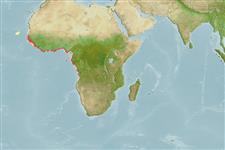>
Pleuronectiformes (Flatfishes) >
Cyclopsettidae (Sand whiffs)
Etymology: Citharichthys: Latin, cithara = lire like instrument + Greek, ichthys = fish (Ref. 45335).
Eponymy: Franz Xaver Stampfli (1847–1903) was a German (possibly Swiss) naturalist who was working in Liberia (1879–1887). [...] (Ref. 128868), visit book page.
More on author: Steindachner.
Environment: milieu / climate zone / depth range / distribution range
ນິເວດວິທະຍາ
ສັດທະເລ; ນ້ຳຈືດ; ນ້ຳກ່ອຍ ອາໄສຢູ່ໃກ້ໜ້າດິນໃຕ້ພື້ນທ້ອງນ້ຳ; ລະດັບຄວາມເລິກ 0 - 50 m (Ref. 2683). Tropical; 21°N - 18°S, 26°W - 20°E
Eastern Atlantic: Senegal to Angola (Ref. 5979, 81290, 81683). Also reported from Mauritania (Ref. 55783).
ຂະໜາດ / ນ້ຳໜັກ / Age
Maturity: Lm ? range ? - ? cm
Max length : 17.6 cm TL ຕົວຜູ້/ບໍ່ມີເພດ; (Ref. 128374); ນ້ຳໜັກສູງສຸດທີ່ເຄຍຈັດພີມມາ: 73.00 g (Ref. 126037)
ຄີ (ໜາມ)ແຂງຢູ່ຫຼັງປາ (ທັງໝົດ) : 0; ຄີຫຼັງຂອງປາ (ຄີອ່ອນ) (ທັງໝົດ) : 80 - 87; ຄີ(ໜາມ) ແຂງຢູ່ຄີກົ້ນປາ
ກຸ່ມປາກະດູກແຂງ
ຄວາມຖີ່ຂອງກຸ່ມຖ່າຍທອດພັນ
ປາທີ່ມີການເຄື່ອນຍ້າຍຈາກທະເລໄປຫານ້ຳຈືດ ແລະນ້ຳຈືດຫາທະເລ
ປາທີ່ມີການເຄື່ອນຍ້າຍຈາກທະເລແລະໄປໄຂ່ຢູ່ນ້ຳຈືດ
ຄີກົ້ນຂອງປາ
ສັດທີ່ມີກະດູກສັນຫັຼງ
ການຖ່າຍທອດທາງກຳມະພັນຈາກພໍ່ແມ່ຫາລູກ: 0; ຄີກົ້ນຂອງປາ: 59 - 65. Diagnosis: body oval, its depth 45-50% SL (Ref. 81290, 81683). Head length 27-31% SL; eye diameter 16-23% HL; teeth in a single row on upper as well as lower jaw, no caniniform teeth (Ref. 81683). Interorbital space narrow and slightly concave (Ref. 81290, 81683). Hind end of maxilla extending to below centre of eye (Ref. 81290, 81683) but never posterior to posterior edge of pupil (Ref. 81683). Fin base length of both pelvic fins short and of about equal length (Ref. 81683). Body covered with cycloid or weakly ctenoid scales (Ref. 81290, 81683). Gill rakers moderately long and slender (Ref. 81290, 81683), about 2/3-3/4 length of gill filaments at angle of gill arch (Ref. 81683).
Coloration: eyed side yellowish brown with dark spots along dorsal and anal fins; dark brown spot at base of caudal fin, as well as on upper and lower caudal fin rays; dorsal and anal fins with a series of dark brown spots; blind side entirely whitish (Ref. 81620, 81683).
Occurs in coastal waters (Ref. 2683, 81290) and brackish water of estuaries and lagoons (Ref. 81290, 81683), also ascending rivers (Ref. 81683) and entering freshwater (Ref. 2683). Feeds on fish, shrimps and crabs (Ref. 28587).
Life cycle and mating behavior
ການຈະເລີນເຕັມໄວ | ການສືບພັນ | ການວາງໄຂ່ | ໄຂ່ | ຄວາມດົກຂອງໄຂ່ປາ | ຕົວອ່ອນ
Distinct pairing (Ref. 205). Oviparous (Ref. 101737). Females produce numerous eggs in multiple spawnings during a prolonged spawning period (Ref. 101737).
Aldebert, Y., M. Desoutter and J.-C. Quéro, 1990. Bothidae. p. 1027-1036. In J.C. Quero, J.C. Hureau, C. Karrer, A. Post and L. Saldanha (eds.) Check-list of the fishes of the eastern tropical Atlantic (CLOFETA). JNICT, Lisbon; SEI, Paris; and UNESCO, Paris. Vol. 2. (Ref. 5979)
IUCN Red List Status (Ref. 130435: Version 2024-2)
Threat to humans
Harmless
Human uses
ການປະມົງ: ເປັນສີນຄ້າ
ເຄື່ອງມື
Special reports
Download XML
ແຫຼ່ງອີນເຕີເນັດ
Estimates based on models
Preferred temperature (Ref.
123201): 23.7 - 28, mean 26.7 °C (based on 66 cells).
Phylogenetic diversity index (Ref.
82804): PD
50 = 0.5000 [Uniqueness, from 0.5 = low to 2.0 = high].
Bayesian length-weight: a=0.00490 (0.00320 - 0.00749), b=3.28 (3.16 - 3.40), in cm total length, based on LWR estimates for this species & Genus-body shape (Ref.
93245).
ຊັ້ນເຂດຮ້ອນ (Ref.
69278): 3.9 ±0.55 se; based on food items.
ຄວາມຢືດຢຸ່ນ (Ref.
120179): ສູງ, ປະຊາກອນຕຳ່ສຸດທີ່ໃຊ້ເວລາສອງໜ້ອຍກວ່າ 15 ເດືອນ (Preliminary K or Fecundity.).
Fishing Vulnerability (Ref.
59153): Low vulnerability (10 of 100).
Nutrients (Ref.
124155): Calcium = 279 [133, 549] mg/100g; Iron = 1.31 [0.64, 2.52] mg/100g; Protein = 17.1 [15.0, 19.1] %; Omega3 = 0.167 [0.079, 0.343] g/100g; Selenium = 48.1 [21.8, 105.2] μg/100g; VitaminA = 15.6 [4.7, 57.4] μg/100g; Zinc = 1.36 [0.89, 2.02] mg/100g (wet weight);
